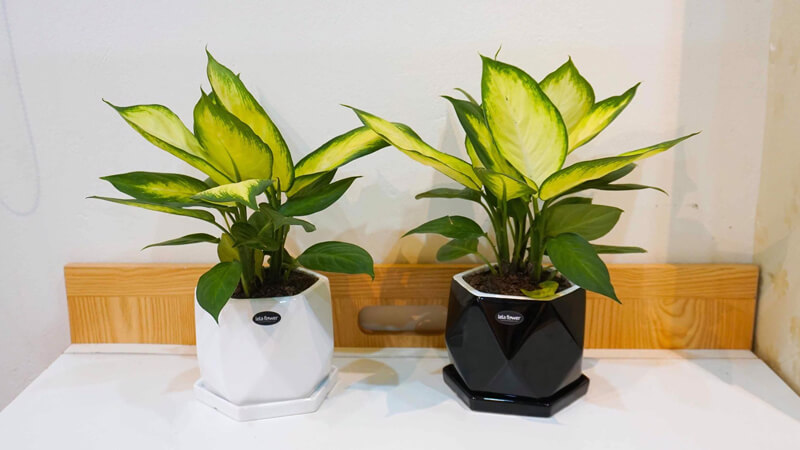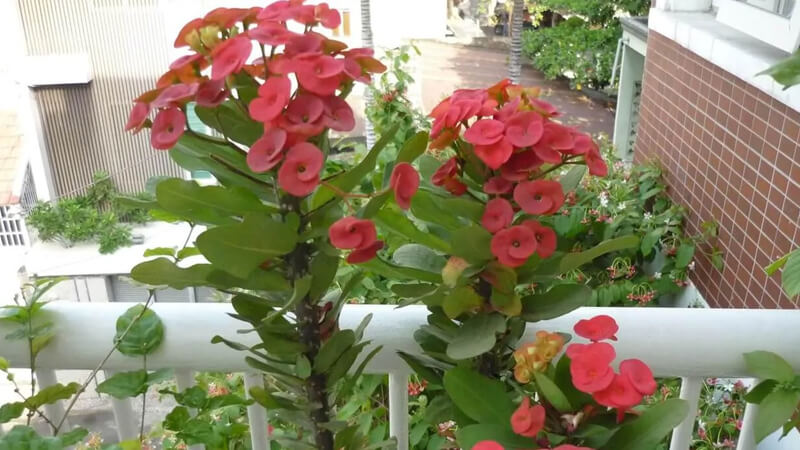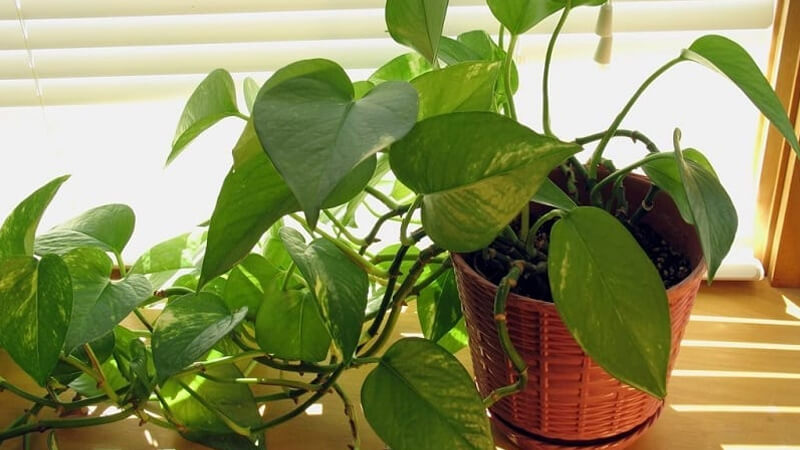Ornamental plants are not only used for home decoration but also for air purification and are believed to bring good luck and fortune. However, not many people are aware that some plant species contain toxic substances that can cause poisoning and even lead to death if accidentally chewed. Let’s explore this issue in more detail to be cautious when planting any ornamental plants.
1 Oleander
With the scientific name Nerium oleander, belonging to the Apocynaceae family, this plant’s sap is creamy, turning from ivory to greenish. If accidentally touched or ingested, it can cause vomiting, extreme fatigue, headaches, dizziness, and loss of strength.
More severe consequences include low blood pressure, cardiac arrhythmia, deep coma, and even death if not treated promptly.
 Oleander’s sap induces vomiting, extreme fatigue, headaches, and dizziness
Oleander’s sap induces vomiting, extreme fatigue, headaches, and dizziness
Therefore, it is not recommended to plant oleander near water sources such as wells or reservoirs because its falling leaves and flowers can contaminate the water.
2 Jatropha
Jatropha, with the scientific name Jatropha podagrica, is also known as water hyacinth, mountain lotus, or oil-bearing plant with a bulb. Its bark and leaves, when used appropriately, can cure hair loss, mouth ulcers, and skin diseases.
However, the plant’s stem, bulb, and seeds contain the toxic substance Curcin, which causes a burning sensation in the throat, vomiting, diarrhea, and abdominal pain. If ingested in larger quantities, it can lead to cardiac and circulatory disturbances and central nervous system depression.
 Jatropha contains Curcin, inducing throat irritation, vomiting, diarrhea, and abdominal pain
Jatropha contains Curcin, inducing throat irritation, vomiting, diarrhea, and abdominal pain
In case of poisoning, it is crucial to administer fluid therapy and gastric lavage to eliminate the toxins from the body and replenish lost fluids due to electrolyte imbalances, diarrhea, and vomiting.
3 Dumb Cane
Scientifically known as Dieffenbachia Amoena, this plant is easy to grow and has an attractive appearance, making it a popular choice for indoor ornamental plants.
All parts of the plant, from root to tip, contain toxins. The plant’s sap contains andromedotoxin and arbutin glucoside, which cause tongue numbness, tongue redness, and a burning sensation if chewed or swallowed, and may lead to an inability to speak due to throat stiffness.
 Dumb Cane contains andromedotoxin and arbutin glucoside
Dumb Cane contains andromedotoxin and arbutin glucoside
If you accidentally come into contact with the plant’s sap, it is advisable to neutralize it by applying heat, such as by using a hairdryer or rinsing with warm water.
4 Crown of Thorns
Also known as the flower of eight fairies or the flower of thorns, this plant’s scientific name is Euphorbia milii splendens. It can grow in low-light conditions, has beautiful flowers, and is easy to cultivate, making it a popular choice for many.
The plant’s stem is covered with sharp thorns that can easily pierce and scratch the skin if not handled carefully. Its milky-white sap, when in contact, can cause a burning sensation and, if ingested, can impair the immune system and lead to blindness or reduced vision if it gets into the eyes.
 Crown of Thorns’ sap can cause blindness or reduced vision if it gets into the eyes
Crown of Thorns’ sap can cause blindness or reduced vision if it gets into the eyes
5 Hyacinth
Hyacinth, also known as night-blooming jessamine, has the scientific name Hyacinth orientalis. Its fragrant and colorful flowers bloom at night, attracting many gardeners.
However, its bulbs contain high levels of the toxic substance Alkaloid, which can cause muscle spasms and digestive issues such as bloating, nausea, and diarrhea if ingested.
 Hyacinth bulbs contain toxic Alkaloids
Hyacinth bulbs contain toxic Alkaloids
6 Burro’s Tail
Burro’s Tail, also known as string of pearls, has the scientific name Sedum morganianum. It is often grown indoors in pots to purify the air.
Despite its benefits, this plant contains the toxic substance glucoside, which, if ingested, can lead to fatigue, diarrhea, respiratory problems, shortness of breath, and increased heart rate.
 Burro’s Tail contains toxic glucosides
Burro’s Tail contains toxic glucosides
7 Rhododendron
With the scientific name Rhododendron occidentale, rhododendron boasts colorful and vibrant flowers. When used appropriately, it can help reduce pain, lower heart rate, and decrease blood pressure.
However, this plant contains the dangerous toxins Andromedotoxin and Arbutin glucoside. If ingested, these toxins can cause excessive salivation, vomiting, dizziness, ringing in the ears, and difficulty breathing. Even a small amount of its leaves can lead to severe poisoning in children.
 Rhododendron contains dangerous toxins Andromedotoxin and Arbutin glucoside
Rhododendron contains dangerous toxins Andromedotoxin and Arbutin glucoside
8 Pothos
Belonging to the Araceae family, pothos can thrive in both soil and water environments and is commonly grown indoors for air purification.
However, its leaves, stems, and especially petioles contain the toxic substance Calcium Oxalate, which can cause a burning sensation in the mouth, throat, and intestines if chewed. More severe consequences include coma, anaphylactic shock, and even death.
 Pothos contains Calcium Oxalate, leading to mouth and throat irritation
Pothos contains Calcium Oxalate, leading to mouth and throat irritation
9 Allamanda
Also known as golden trumpet, this plant has yellow flowers and a climbing habit, making it ideal for creating fences.
All parts of the plant, including its stem, bark, flowers, leaves, seeds, and sap, contain toxins that can affect the digestive system, causing abdominal pain, diarrhea, vomiting, and symptoms such as lip swelling and dizziness.
 Allamanda contains toxins affecting the digestive system
Allamanda contains toxins affecting the digestive system
10 Sago Palm
With the scientific name Cycas revoluta Thunb, this plant’s stem contains Alkaloids, which are potentially carcinogenic, and its seeds contain Cycasin, which is toxic to children.
 Sago Palm contains potentially carcinogenic Alkaloids
Sago Palm contains potentially carcinogenic Alkaloids
These are the top ten ornamental plants with toxic properties that can be harmful if touched or ingested. Therefore, it is essential to be cautious and well-informed before planting any of these species to avoid adverse health effects.
Cook with aluminum pot like this, not only does the food taste bad, but it also produces ‘toxic substances’
When it comes to kitchenware, aluminum is a popular choice for its versatile applications. From pots and pans to cooking utensils, this lightweight material offers convenience and efficiency in the kitchen. However, it is important to note that using aluminum products requires some caution to ensure the safety of your health.
What’s the Damage: The Lip-Licking Habit in Cold Weather
“Unbeknownst to many, there are certain habits that we consider harmless but can be incredibly detrimental to our well-being. One such habit is lip-licking, especially during colder months. It may seem like a benign action, but it can actually lead to drier lips. Join us as we delve into the surprising ways this seemingly innocent habit can cause harm and what you can do instead to maintain healthy, hydrated lips.”





































